21:00 The royal mummies arrived at the National Museum of Egyptian Civilisation, where Egyptian President Abdel-Fattah El-Sisi was in their reception
20:45 Finally, the royal mummies arrived at the National Museum of Egyptian Civilisation (NMEC) in Egypt’s first Islamic capital of Al-Fustat.
20:40 A ceremonial 21-gun salute was performed upon the arrival of the royal mummies at their new residence after a 45-minute journey from their decades-long residence at the Egyptian Museum in Tahrir Square.
20:10 The royal mummies leave their decades-long residence in the Egyptian Museum in Tahrir Square to the National Museum of Egyptian Civilisation in Egypt’s first Islamic capital, Al-Fustat
20:00 The inauguration of the National Museum of Egyptian Civilisation witnessed the screening of a documentary, dubbed Egypt is the civilisation and starring the artist Khaled Al-Nabawi, which presented the phases of developing the Egyptian archaeological museums.
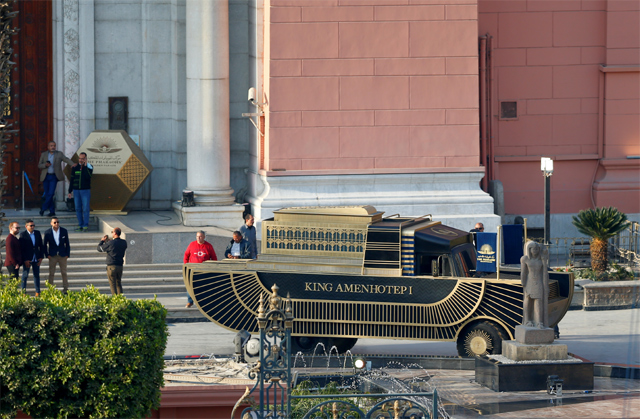
The mummy of King Amenhotep I is transported in a convoy from the Egyptian Museum in Tahrir to the National Museum of Egyptian Civilization in Fustat, in Cairo, Egypt April 3, 2021. REUTERS
19:25 Egyptian President Abdel-Fattah El-Sisi inaugurated on Saturday the National Museum of Egyptian Civilisation (NMEC), to which 22 ancient Egyptian royal mummies will be moved from the Egyptian Museum in Tahrir Square.
The long-awaited journey will see the transfer of the mummies of 18 kings and four queens through the streets of Cairo to their new resting place.
The president is set to receive the royal mummies in their new residence.
Before touring the new edifice, President El-Sisi was briefed on a detailed explanation of the Interior design of the NMEC by the Minister of Tourism and Antiquities Khaled El-Anany.
19:15 The long-awaited Pharaohs' Golden Parade has kicked off in downtown Cairo, where 22 ancient Egyptian royal mummies will be moved from the Egyptian Museum in Tahrir Square to the National Museum of Egyptian Civilisation (NMEC) in Fustat.
The journey, which is set take around 45 minutes, will see the transfer of the mummies of 18 kings and four queens through the streets of Cairo to their new resting place.
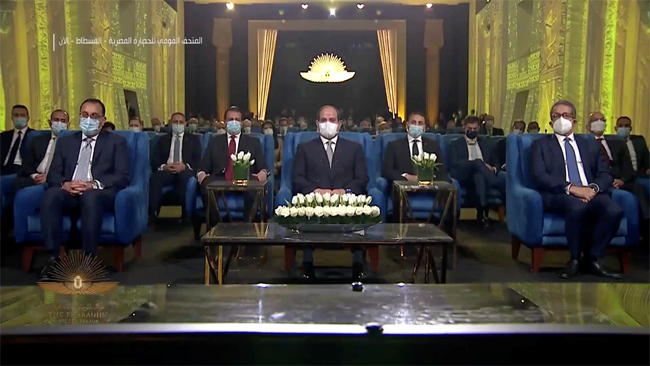
Egypt's President Abdel-Fattah al-Sisi attends a ceremony of a transfer of Royal mummies from the Egyptian Museum in Tahrir to the National Museum of Egyptian Civilization in Fustat, in Cairo, Egypt April 3, 2021. Host Broadcaster/REUTERS
19:10 Egyptian President Abdel-Fattah El-Sisi arrived at the National Museum of Egyptian Civilisation (NMEC).
19:00 Egyptian President Abdel-Fattah El-Sisi said on Saturday that he is looking forward to receiving the ancient kings and queens of Egypt at the National Museum of Egyptian Civilisation (NMEC) later today.
"This majestic scene is new evidence of the greatness of [the Egyptian] people, the guardian of this unique civilisation that roots back into the depth of history," El-Sisi wrote on his social media accounts.
"I invite all Egyptians and the whole world to follow this unrivalled event – evoking the spirit of the great ancestors who preserved the homeland and created a civilisation in which all humanity takes pride – to keep on our path that we have started: the path of construction and humanity," the president added.
18:30 The first mummy to lead the parade is that of King Seqnenre, the warrior who led the liberation war against the Hyksos, then the kings will follow according to chronological order.
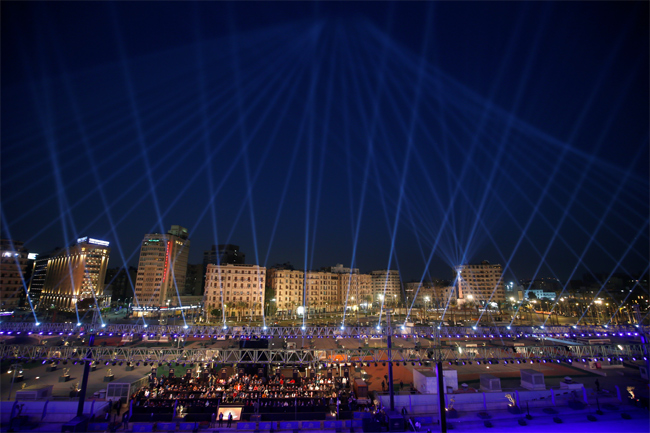
General view shows Tahrir Square ahead of a transfer of Royal mummies from the Egyptian Museum in Tahrir to the National Museum of Egyptian Civilization in Fustat, in Cairo, Egypt April 3, 2021. REUTERS
Upon passing Tahrir square, lights will illuminate and the curtains will be removed to show a soared obelisk and four ram-headed sphinxes.
The logo of the parade was inspired by ancient Egyptian belief as it consists of the sacred scarab and the falcon wings, symbolising eternity and resurrection. The colours chosen are dark blue and gold, representing ancient Egyptian deities. According to ancient Egyptian belief, the gods have skin made of gold and hair made of the precious stone of Lapis Lazuli.
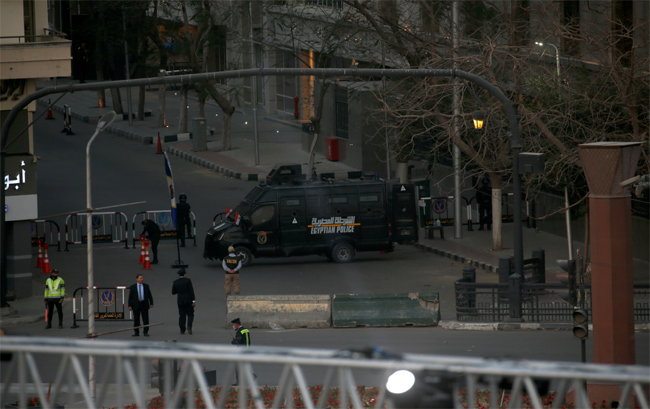
A police vehicle secures the entrance to Tahir Square as royal mummies are transported in a convoy from the Egyptian Museum in Tahrir to the National Museum of Egyptian Civilization in Fustat, in Cairo, Egypt April 3, 2021. REUTERS
Around 20 renowned Egyptian actors and singers are participating in the parade among them Yosra, Mona Zaki, Ahmed Helmy, Hussein Fahmy, Asser Yassin, Nelly Karim, Amina Khalil, Karim Abdel-Aziz, Ahmed Ezz and singer Mohamed Mounir among others.
Renown musician Nader Abbasy will be leading the orchestra.
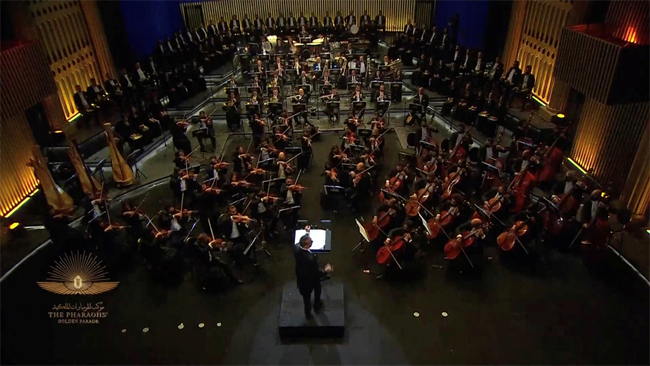
Musicians perform during a ceremony of a transfer of Royal mummies from the Egyptian Museum in Tahrir to the National Museum of Egyptian Civilization in Fustat, in Cairo, Egypt April 3, 2021. Host Broadcaster/REUTERS
The square has been converted into an open-air museum, hosting a pharaonic exhibition with a historical pathway open to the public, functioning as an extension of the Egyptian museum.
After the inauguration, the square will be home to a 17-metre-tall, 90-ton obelisk from the era of Ramses II. It will also accommodate four ram-headed sphinxes as prime attractions. The square is dotted with many pharaonic-era florae like that of palm and olive trees.
18:00: Among the parade's attendees are Audrey Azoulay Director-General of UNESCO, Zurab Pololikashvili Director-General of UNWTO, Harry Theocharis Tourism Minister of Greece and the Tourism Minister of Saudi Arabia Ahmed Al-Khatib.
17:45:The royal mummies are to embark, within hours on a journey across Cairo to attain their final resting place at the National Museum of Egyptian Civilisation (NMEC) in Fustat.
The royal ancient Egyptian funerary procession will be revived, with a little twist. This time the royals will not be crossing the Nile from the east to be buried in their tombs in the west, for eternity. They will however, be following ancient Egyptian rituals, where the mummies are accompanied by prayers and spells from the book of the dead, like it was always done in the ancient times, along with boxes that included all their possessions and funeral music playing in the background.
Tonight, the royal mummies will be crossing the streets of Cairo in a golden unrivalled parade along the Cairo Nile Corniche from the Egyptian Museum in Tahrir (EMC) to their final destination at the National Museum of Egyptian Civilization (NMEC), overlooking Ain Al-Sira lake, now known as Ain Hayat in Fustat.
They will be transported on 22 vehicles shaped like a pharaonic boat that had always transported the royals deceased to eternity. The vehicles are decorated with pharaonic scenes and decorations.
Around 60 motorcades will be led by 22 ancient Egyptian shaped chariots drawn by 44 horses. Upon their arrival at the NMEC, the mummies will be welcomed with full military honors befitting royalties. A collection of 150 horses and knights will say goodbye to the royal mummies upon their departure from Tahrir and welcome them upon arrival to NMEC.
16:45:UNESCO director Audrey Azoulay said the mummies' transference to a new residence "marks the end of much work to improve their conservation and exhibition.
"We will see the history of Egyptian civilization unfold before our eyes," AFP quoted Azoulay as saying.
14:30: Soha Bahgat, the tourism ministry spokesperson, said Egyptian President Abdel-Fattah El-Sisi will arrive at the National Museum of Egyptian Civilisation to receive the royal mummies
13:30: Renowned Egyptian conductor Nader Abbasi and his United Philharmonic Choir and Orchestra will perform tonight at the parade.
12:30: Secretary-General of the World Tourism Organisation (WTO) Zurab Pololikashvili and Egyptian Minister of Tourism and Antiquities Khaled El-Anany inspected the National Museum of Egyptian Civilisation in Egypt’s first Islamic capital, Al-Fustat, to which the mummies will be moved after the parade.
Egypt is organizing tonight the historic Pharaohs' Golden Parade to move 22 ancient Egyptian royal mummies, including 18 kings and four queens, through the streets of Cairo to their new resting place.
The royal mummies will be moved from their decades-long residence in the Egyptian Museum in Tahrir Square to the National Museum of Egyptian Civilisation in Egypt’s first Islamic capital, Al-Fustat.
The procession, which has dominated headlines and captured the world's attention, will see the royal mummies transported on the Nile and then accompanied by chariots and horses.
The parade will move amid tight security measures which include the closure of some roads. The entry and exit points to Tahrir Square, including those from 6 October Bridge and 15 May Bridge, will be closed as well as the Qasr El-Nil Bridge, El-Gamaa Bridge, Abbas Bridge and Misr-Helwan Road.
UNESCO Director-General Audrey Azoulay, Secretary-General of the World Tourism Organization (WTO) Zurab Pololikashvili, officials, actors, and key figures will attend the parade.
The 22 mummies in the parade were discovered in two cachettes. The first was unearthed in 1881 at Deir El-Bahari in Luxor’s West Bank in tomb TT320.
The royal mummies found in the first cachette included those of the kings Seqenenre Taa, Ahmose I, Amenhotep I, Thutmose I, Thutmose II, Thutmose III, Seti I, Ramses II, Ramses III, Ramses IX, and Queen Ahmose-Nefertari.
The second cachette was found in a chamber in the tomb of King Amenhotep II (KV 35) by French Egyptologist Victor Loret in 1898, at the Valley of the Kings in Luxor.
Among the royal mummies found in this cachette were those of kings Amenhotep II, Thutmose IV, Amenhotep III, Merenptah, Ramses IV, Ramses V, Ramses VI and Seti II.
Queens Tiye, Meritamun, and Hatshepsut are also among the royal mummies.
Short link: